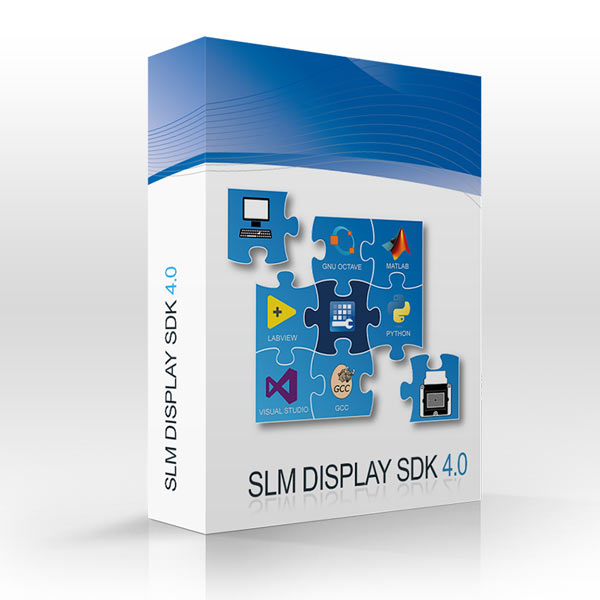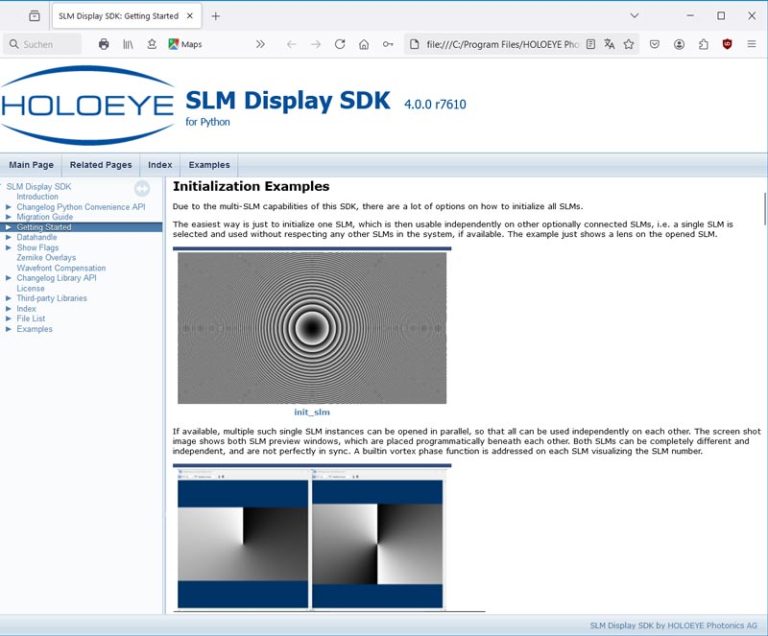全站搜索
Search the entire website
Search the entire website

The HOLOEYE SLM Display Software Development Kit (SDK) is an interface to show images and phase arrays directly on the SLM within many programming languages. It also supports data manipulation functions like phase overlay calculated from Zernike coefficients, optical beam manipulations, and data transformations.
The SDK enables the use of multiple SLM devices connected to the same computer within the same application independently. It is also possible to tile the SLM display area to use multiple functions independently on a single SLM display device or use multiple SLM devices merged within an NVIDIA Mosaic setup to allow perfect hardware synchronization.
To use the SDK you need to have one of the following supported development environments installed:
The current SDK version is available for Microsoft Windows 10 and above (Windows 64 bit versions). The SDK supports all current HOLOEYE Spatial Light Modulators with resolutions up to 4160 x 2464 pixel.
The initialization of the SLM or multiple SLMs [within the target platform] is reduced to the minimum required amount of code. It is possible to use multiple SLM devices or split one SLM display into multiple SLM canvas.
Data can be transferred to the SLM from floating point or integer phase or image data arrays. The SLM Display SDK supports upload and display of data stored in all common image file formats.
The loaded data can be addressed including beam manipulation overlay functions like blazed gratings (beam steering or reposition of the projected hologram), lens functions (focus adjustment), Zernike functions or Wavefront compensation data (which typically is delivered with the SLM).
The SDK also includes built-in speed-optimized commands for the display of essential functions (e.g. lenses, gratings) on the SLM.
The SDK permits sophisticated management of data uploaded to the graphics adapter’s memory (VRAM) and provides detailed information about the timing when the data is actually displayed on the SLM at high frame rates.

We provide a set of code examples which demonstrate the features of the SLM Display SDK.
The examples demonstrate the basic functions and highlights the values which can be adjusted.
We recommend using the examples to start working with the SDK. Even if you have limited experience in programming within one of the supported environments, the examples offer a straightforward starting point as you get immediate feedback on how it works and how changes of parameters affect the result.

To get access to the SLM Display SDK, please register at our download website.
(LC 2012, PLUTO, PLUTO-2 & 2.1, LETO-3, ERIS):
Minimum Requirements:
Processor: Dual core CPU with 2 GHz (e. g. Intel Core 2 Duo E6320)
Memory: 2 GB
Graphics Card: DirectX 11 capable GPU with minimum 256 MB Video RAM (e.g. Nvidia Geforce 7800 GT or built-in Intel GPU or equivalent)
Recommended Requirements:
Processor: Quad core CPU with 3 GHz (e.g. Intel Core i5-2500)
Memory: 8 GB
Graphics Card: Nvidia or DirectX 11 capable GPU with 2 GB Video RAM (e.g. Nvidia GTX750)
(GAEA-2):
Minimum Requirements:
Processor: Quad core CPU with 3 GHz (e. g. Intel Core i5-4690)
Memory: 8 GB
Graphics Card: DirectX 11 capable GPU with minimum 2 GB Video RAM and HDMI 2.0 output (e.g. Nvidia GTX950 or similar)
Recommended Requirements:
Processor: Quad core CPU with 4 GHz (e.g. Intel Core i7-7700k)
Memory: 16 GB or more
Graphics Card: Nvidia or DirectX 11 capable GPU with 8 GB Video RAM and HDMI 2.0 output (e.g. Nvidia GTX1070)
实验系统配置 系统原理 先把一束水平偏振的高斯光束聚焦到一个旋转的毛玻璃漫射器上面,利用漫射器带来的随机相位扰动来生成空间非相干光束。然后把非相干光导入到空间光调制器的三次相位模板上,通过一个傅里叶转换透镜在焦点的位置产生空间Airy非相干光束...
查看全文The orbital angular momentum (OAM) multiplexing holography has the advantages of large information capacity and high security, and has important application value in holographic storage, optical encryption, and optical computing. However, as the...
查看全文此前,青亭网曾报道过NVIDIA、三星、剑桥大学等对空间光调制器(SLM)全息方案的探索。空间光调制器可调节光波的空间分布,在电驱动信号控制下,可改变光在空间中传播的振幅、强度、相位、偏振态等特性,从而形成全息影像。自动驾驶汽车的LiDAR传感器也使用了空间光...
查看全文实验系统配置 系统原理 激光能量由半波片和格兰棱镜控制,通过旋转半波片实现激光能量控制。光束经过由透镜1和透镜2组成的扩束器、反射镜后,入射到SLM的液晶面。SLM通过加载闪耀光栅,改变入射光的相位分布,实现光束反射角的调制。SLM是一个衍射光学元件...
查看全文